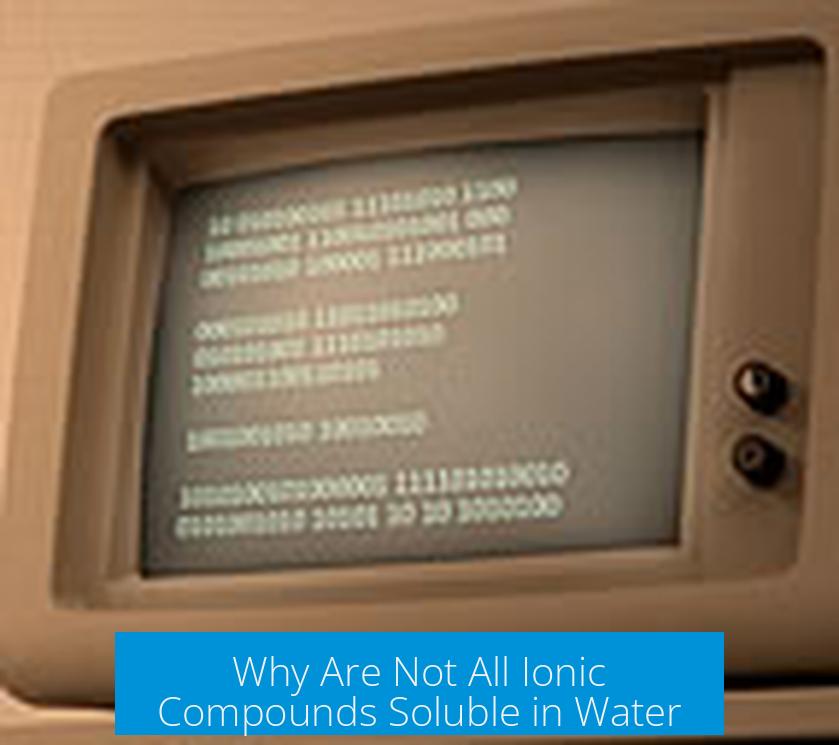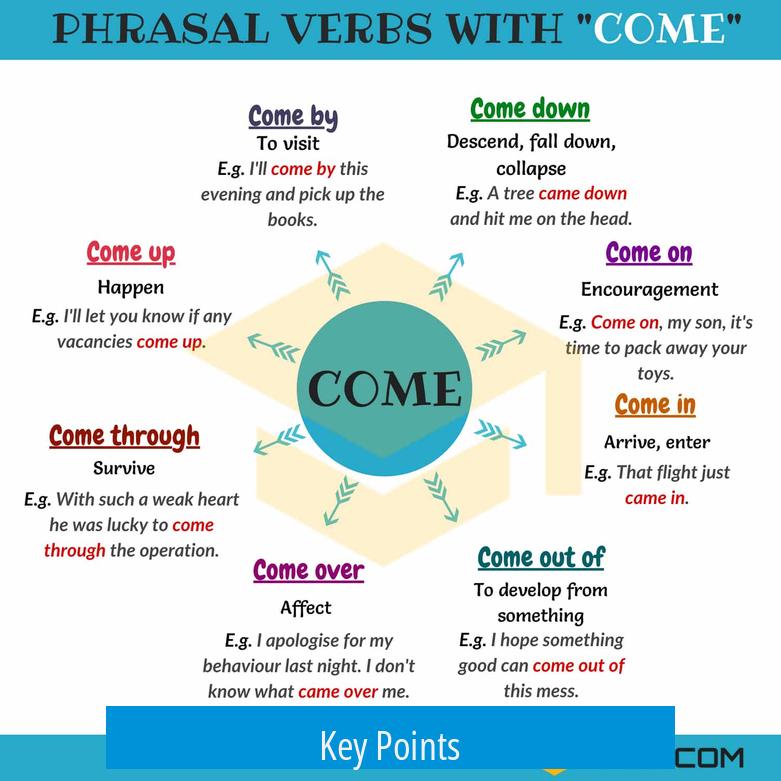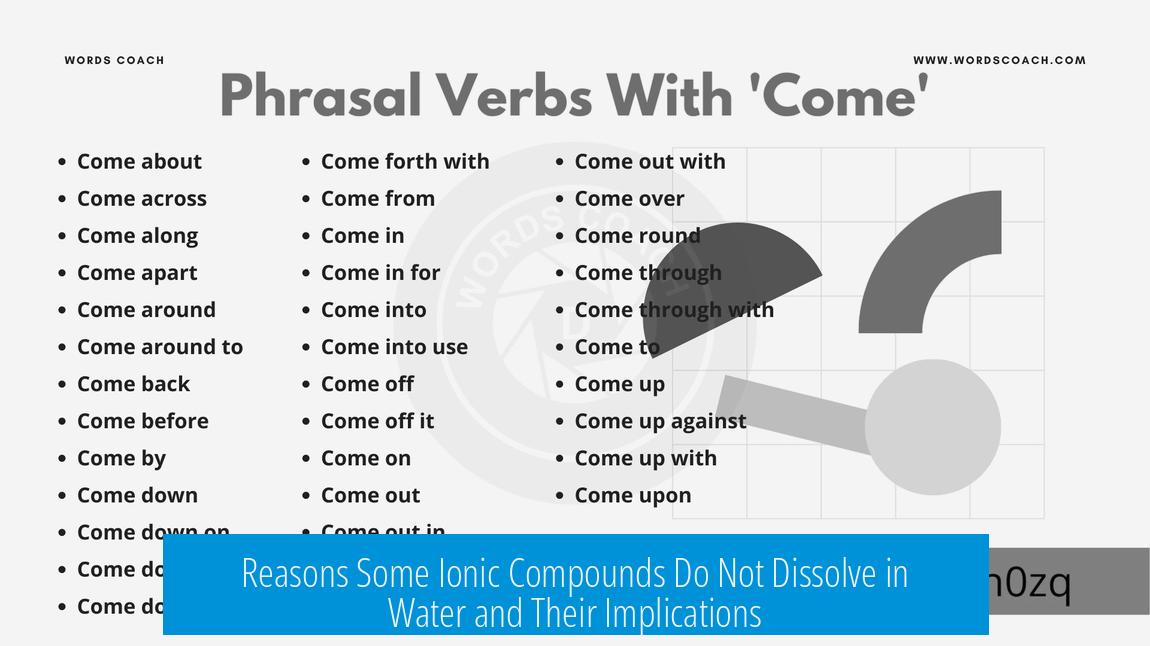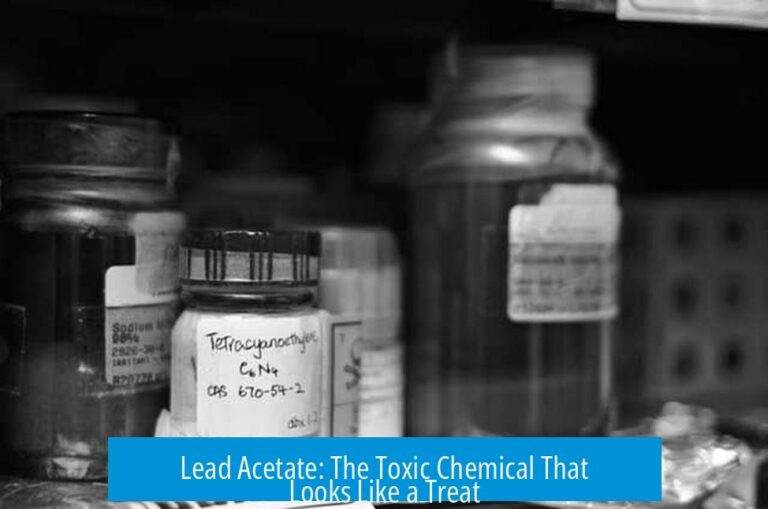Why Are Not All Ionic Compounds Soluble in Water?

Not all ionic compounds dissolve in water because their solubility depends on the balance between lattice energy and hydration energy. This energy interplay determines whether an ionic compound will break apart and disperse in water.
Energy in Ionic Crystal Formation
Ionic compounds form crystals by attracting positive and negative ions.
When they form a crystal lattice, energy is released. This energy, called lattice energy, stabilizes the solid structure.
To dissolve, ions must be pulled out from this stable crystal. This requires energy input equal to the lattice energy.
Hydration Energy in Water
When ions enter water, they attract water molecules around them, a process called hydration or solvation.
This interaction releases energy, known as hydration energy.
This energy helps compensate for the energy needed to separate ions from the crystal.
Balancing Energies and Solubility
- If the lattice energy is too high, meaning ions strongly stick together, it demands more energy to separate them.
- If hydration energy is insufficient to make up for this separation energy, the ionic compound remains solid and does not dissolve.
- When hydration energy equals or exceeds the lattice energy, ions disperse in water, and the compound dissolves.
Key Points

- Ionic compounds form stable crystals by releasing lattice energy.
- Separating ions needs energy to overcome this lattice energy.
- Hydration energy from water molecules helps to pull ions into solution.
- Solubility depends on whether hydration energy can match or surpass lattice energy.
- High lattice energy and low hydration energy lead to low solubility.
How Come Not All Ionic Compounds Are Soluble in Water?
Not all ionic compounds dissolve in water because the energy needed to break the crystal lattice is not fully offset by the energy released when water molecules surround the ions. In other words, it’s a tug-of-war between the forces holding the compound together and those pulling it apart. If the energy holding the ions in a crystal is too strong, water simply can’t pry them loose. But let’s dive deeper and explore this fascinating balance of forces that decides whether an ionic compound greets water as a friend or foe.
Imagine an ionic compound as a tight-knit, cozy family. The ions are happily snuggled close, forming a crystal lattice that releases energy and stabilizes the entire structure. This is called the lattice energy. When ions join the crystal, they give up energy—a bit like settling into a comfy home after a long journey.
This energy release during crystal formation holds the ionic compound together. To break this bond and pull ions loose, energy must be pumped back in. Think of it as breaking up a famously tight-knit group; it’s hard work. This required input is exactly the energy needed to tear ions away from the lattice, a process essential for dissolving the compound.
The Battle Between Lattice Energy and Hydration Energy
Now, when you toss that ionic compound into water, the game changes. Water molecules rush to surround each freed ion in a process called hydration. This isn’t just water chilling with ions; it’s a serious energy-releasing event. Water molecules sacrifice part of their energy to cling tightly around ions, giving off hydration energy.
This hydration energy, in a way, acts like a reward system for the ions. It’s as if the ions are being welcomed into a new environment that compensates for the energy they lose by leaving their crystal home. The more energy water can give back, the easier it is to pull ions away from the lattice.
Why Some Ionic Compounds Refuse to Dissolve
Here’s the crux: the solubility of an ionic compound boils down to the balance between two energies—the lattice energy keeping ions cozy together, and the hydration energy drawing them apart.
- If lattice energy is super high, ions are basically glued tightly in place.
- If hydration energy can’t match or exceed the energy needed to break those bonds, the compound stays solid and insoluble.
A good example is barium sulfate (BaSO4). Despite being ionic, it barely dissolves in water. The lattice energy is so high that water molecules don’t gain enough energy from hydration to snatch the ions away. Meanwhile, sodium chloride (table salt) dissolves easily because its lattice energy is much lower, and water’s hydration energy is sufficient to pull those ions free.
Practical Implications: Why Should You Care?

Knowing why some ionic compounds don’t dissolve is not just abstract chemistry—it has real-world uses and implications. For example, in water treatment facilities, insoluble ionic compounds can be problematic as they form scale or sediment. Understanding the energy balance helps engineers pick proper chemicals to prevent or dissolve these stubborn deposits.
Similarly, in pharmaceuticals, solubility is king when designing drugs. An insoluble salt won’t efficiently deliver medication inside your body because it won’t dissolve well in watery environments like blood.
Personal Experience: Salt vs. Chalk
You’ve probably experienced this slow-motion test in your kitchen or classroom. Drop some table salt into water—it disappears almost instantly. Now try chalk powder, primarily calcium carbonate. It barely budges, despite feeling chalky and apparently “dry.” Why? Chalk’s ions stick tightly together due to high lattice energy. Water just can’t prize them apart without a lot of effort it doesn’t get back from hydration.
This difference highlights how energy dynamics in dissolving ionic compounds play out not only in labs but in everyday life.
Additional Tips and Recommendations
- To improve solubility of tough ionic compounds, heating water helps. Higher temperatures increase hydration energy and provide thermal energy to break lattice bonds.
- Using solvents with stronger ion-dipole interactions than water might work if water fails to dissolve the compound well.
- Adding chemicals that disrupt the crystal lattice (like complex formers) can ease dissolution by lowering lattice energy.
Final Thoughts
The solubility of ionic compounds is not merely a yes-or-no question. It’s the result of a delicate dance of energies. The compound’s lattice energy creates a fortress, while hydration energy is the key that can unlock it—if strong enough. Without enough hydration energy, those ions remain locked in place, and the compound grudgingly stays put.
Next time you drop salt into your soup or notice stubborn mineral buildup in your faucet, remember this invisible energy struggle shaping the fate of those ions. Pretty neat how chemistry works, right?
Why do some ionic compounds not dissolve in water despite it being a polar solvent?
Some ionic compounds have very strong crystal lattices. The energy needed to separate their ions exceeds the energy released by hydration. Thus, they remain insoluble in water.
What role does lattice energy play in the solubility of ionic compounds?
Lattice energy is the energy holding ions tightly in the crystal. If this energy is high, it prevents ions from separating, reducing solubility.
How does hydration energy affect the dissolving process of ionic compounds?
Hydration energy is released when water molecules surround and stabilize ions. This energy helps break ions free from the crystal lattice, aiding dissolution.
Can an ionic compound dissolve if hydration energy is less than lattice energy?
No, dissolution requires hydration energy to at least balance lattice energy. If hydration energy cannot compensate, the compound remains insoluble.
Does every ionic compound have the same balance of lattice and hydration energies?
No. Different ionic compounds have varying lattice strengths and hydration energies. This difference determines whether they dissolve in water or not.





Leave a Comment